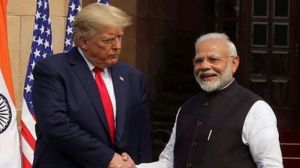Short Circuit
David versus Goliath. Or Kashish Dasani versus Aamir Khan. What promised to be a one-sided battle eventually surprised cinephiles at this ye...

David versus Goliath. Or Kashish Dasani versus Aamir Khan. What promised to be a one-sided battle eventually surprised cinephiles at this year’s Locarno Inter-national Film Festival.
Dasani is Sainath Chowdhury’s 10-year-old hero in Village Football, a heart-warming short film about village children in the middle of an unusual football game. The little star was ecstatic as the 85-second film he acted in became the first Indian film—and the shortest ever—to open the festival.
Chowdhury’s short beat the Khan-Ketan Mehta-Bobby Bedi magnum opus to become a part of Locarno lore. Back in Mumbai, a thrilled Chowdhury says, ‘‘Short films are in a sense a short cut to the international circuit. Walter Salles (of The Motorcyle Diaries and Dark Water fame) saw my film along with Aparna Sen. With that kind of platform, the sky’s the limit.’’ Village Football will be screened next at the 2006 football World Cup in Berlin.
An assistant director at Prasoon Pandey’s Corcoise Films, Chowdhury chucked a client servicing job in Doyle Dane Bernbach (DDB), Dubai, for films. ‘‘The idea of telling a story on 3D is fascinating,’’ says the 28-year-old film-maker, who grew up on an eclectic film diet—from Satyajit Ray and Woody Allen to Guru Dutt and Michael Kassowicz.
Chowdhury is part of a small but growing tribe. Short film-makers were never a recognised or sought-after brand in India, until now. Film-makers such as Vidhu Vinod Chopra and a handful of directors from the 1970s’ parallel movement had their go at the short, but it didn’t boost their oeuvre. Doordarshan telecast some of the works, but they were, at best, nothing more than curious experiments.
The new Indian short film-maker—young, driven, largely defiant of the Bollywood formula and in tune with the digital revolution—is in the limelight, talking cinema over wine and cheese on Page 3.
Undaunted by the task of marketing short films in the Indian market, they are cutting costs, taking risks and telling their stories on diverse formats. The short film is their trump card to the international circuit.
Take Ashvin Kumar. The 32-year-old London Film School dropout and son of designer Ritu Kumar was invited to all the celebrity dos after he returned home with an Oscar nomination for his film, Little Terrorist.
The poster boy for Indian short films now airs his opinion on everything from item numbers to the IQ of a Delhiite over air-kisses and lager. He justifies his disdain for Bollywood by saying, ‘‘I comment as an industry observer. I’ve been going to Cannes for the last four years, much before the Aishwarya hype began.’’
Amit’s film The Bypass won Best Film and Best Cinematography at the Kodak BAFTA Short Film Showcase and bagged the second prize at the Turner Classic Movies Classic Shorts awards in 2003. Chowdhury also says he’s staying away from Bollywood bigwigs—‘‘It’s much better to do your own thing than be the seventh AD to a Bollywood director, who’s making a film that you just can’t relate to,’’ he says and recommends advertising as a crash course for greenhorns.
The minuscule market is evident from the severe shortage of venues for short films. For instance, despite its high profile nomination, Little Terrorist only reached audiences through rare screenings (in between regular shows) in select Mumbai multiplexes, film festivals and the stray film club—like the ones organised by Mocha cafe.
‘‘In the beginning, when television really took off in India in the mid-’70s, Doordarshan took some interest in airing short films. But with a complete breakdown in quality checks and standards of film-making, the short format was suffocated,’’ says film-maker Deepa Mehta.
Mehta is not optimistic about the future of short films unless they prove to be marketable. ‘‘The statistics speak for themselves. Only a tiny sliver of the film-going crowd actually watch films at festivals. And, in any case, festivals here are sparsely attended and are too few and far between,’’ she says.
The new breed, however, reasons that the genre’s advantages score over its limited reach. After brief stints with Shekhar Kapur and Rakeysh Mehra, 30-year-old Rajesh Chakraborty refuses to return to feature films. ‘‘I know we short film-makers are a minority, but there’s so much one can do with the medium. It’s more creatively satisfying than anything else,’’ says this National Institute of Design alumnus. His three-minute animated venture, Dhak, won the Award of Excellence for best animation film from the Association Internationale du Film d’Animation (ASIFA) and was runner-up at the Animax Awards in the UK.
Fresh out of the Film and Television Institute of India, Amit assisted film-maker Asif Kapadia on his short film, Sheep Thief, after which he went on to assist Kapadia on his feature, The Warrior (with Irrfan Khan in the lead). Kapadia also produced Amit’s short, The Bypass. Now an enthusiastic member of BAFTA, Amit’s first feature film will be funded by the UK National Film Council. It’s a dream come true for most short film-makers since most of them use the genre as a springboard into feature films. As director Sudhir Mishra puts it, ‘‘Short films are a great way of learning control over the craft of film-making.’’
While shooting for Kapadia’s film, Amit had an epiphany. The film needed a summer look, but the sky was overcast. The shoot seemed impossible. But the moment the cameras were positioned, the clouds cleared. And it stayed that way till 10 minutes after pack-up on the last day of shooting. Then the sky turned grey. And it poured. ‘‘I realised the gods were with me.’’ It’s been raining films for him ever since.
(With inputs from Nitya Rao/New Delhi)





- 01
- 02
- 03
- 04
- 05


![Kadapa, [Andhra Pradesh], 27 May (ANI): Andhra Pradesh Chief Minister N Chandrababu Naidu and state Minister Nara Lokesh in conversation during the Telugu Desam Party's (TDP) annual three-day Mahanadu conclave, in Kadapa on Tuesday. (ANI Photo)](https://images.indianexpress.com/2025/05/tdp.jpg?w=400)





![Kadapa, [Andhra Pradesh], 27 May (ANI): Andhra Pradesh Chief Minister N Chandrababu Naidu and state Minister Nara Lokesh in conversation during the Telugu Desam Party's (TDP) annual three-day Mahanadu conclave, in Kadapa on Tuesday. (ANI Photo)](https://images.indianexpress.com/2025/05/tdp.jpg?w=300)

















